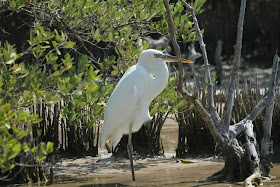 |
| Tricolored Heron |
In the wetlands and coastal areas where I occasionally have opportunity to bird, encounters with
Tricolored Heron and
Little Blue Heron are uncommon. So it was a particular treat to have multiple up-close meetings with both of these beautiful little birds ...
... and yes, at about 2' in height, when you get up-close with these birds you realize that they have lots of legs and neck, and not a lot of body and bulk.
As aside, I'm not sure why the Tricolored Heron was renamed a few years ago, but I much prefer the old name, Louisiana Heron. Giving the bird to a state is undoubtedly filled with historical and geographical inaccuracies, but "Louisiana Heron" has so much more poetry, rhythm, and pleasure for the ear.
 |
| Little Blue Heron |
The Tricolored Herons were in nuptial attire. Note the blue beak which gets both sexes red hot to trot. I was busy taking photos, so I'm not sure if this pair mated, or whether he just mounted her back in a kind of heron foreplay ...
 |
| Tricolored Herons |
These herons disguise themselves with their "curled" neck ...
 |
| Tricolored Heron |
 |
| Little Blue Heron |
... but watch out! They will reach out and grab you in a flash !!
 |
| Tricolored Heron - Strike! |
 |
| Tricolored Heron - hors d'oeuvre ! |
And finally, 2 immature herons, the
Little Blue Heron which is not blue at all, and a
Yellow-crowned Night Heron (another with which I have only rare encounters in the Northeast.
 |
| Little Blue Heron - immature |
 |
| Yellow-crowned Night Heron - immature |
Good Birding!!






































